Schutterij
The principal source is; Singeling, B.Th.G. 1981. "De Delftse schutterij." In De stad Delft: Cultuur en maatschappij van 1572 tot 1667, edited by I.V.T. Spaander and R.A. Leeuw, 140-145. Delft: Stedelijk Museum Het Prinsenhof.
In the Netherlands, the twelfth and thirteenth centuries ushered in progressive urbanization of the growing population. Civic guards or militia, as they are also called, became necessary to protect the towns because traditional private guards of the aristocratic rulers proved insufficient. Protection was required that not only from foreign enemies, but from fire or the floods as well. Popular revolts occasionally had to be put down. Hence the Dutch name for their guards was Schutter (in German: 'schütze', from: 'beschützen') which is "guardian" (to guard, to protect) and not "shooter."
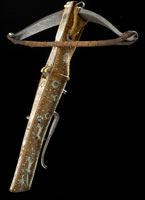
exhibited in the
Legermuseum Delft
Members of the schutterij were selected from the town's wealthy burghers since the lower classes could not afford the appropriate equipment and uniform although some local authorities had occasionally paid for the equipment. Officers and captains were appointed by the city magistrates, and aside their social origin, they had to be members of the Reformed Church. In the words of a Delft edict of 1655, schutters were "the most suitable, most peaceful and best qualified burghers or children of burgers." Their pay, compared to their duties, was negligible consisting of a small subsidy or a partial release from certain taxes. Nevertheless, the membership in a Civic Guard was a matter of civic pride, an honor which led to the development of a kind of civic nobility (burgeredeldom).
Members of the schutterij obeyed strict rules, embedded in the general civil law. In time of war, importance was given to the assigning of colors and symbols for each town so that fellow citizens could be easily identified avoiding confusion in the tangle of a battle.

probably made in the East Indies
Legermuseum Delft
In the Middle Ages, the principal weapons of the Dutch schutterij were the voet or kruisboog (crossbow), the handboog (bow, with arrows) or a pike (long pike or halberd).
The municipality provided the civic guards with shooting ranges, frequently with a building hall for meetings and traditional feasts, including the popular "Papegaai-Schieten," the "Parrot-Shooting" or the banquets made famous by Frans Hals. The patron saints of the traditional Dutch civic guards were either Saint Joris or Saint Sebastiaan.
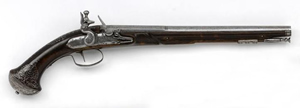
seventeenth century
Legermuseum, Delft
During the sixteenth century, buskruit (gunpowder) came into use for the new hand cannons (e.g. muskets) and pistols which lead to the foundation of special groups of civic guards: the Kloveniers (a kind of musketeers) and larger shooting ranges.
The history of the Delftse Schutterij
The existence of a Schuttersgilde in Delft is first evident from an ordinance by the Delft magistrate from the year 1397, regulating the organization's duties and the rights. This ordinance is the oldest known from any Dutch city. It included exact guidelines as to the age and economic status of the appointed members. Economic solidity was necessary to buy their complete equipment (weapons, uniform). Displays of conflict or envy among the members was strictly forbidden and punished by a fine. In some cases, (perhaps that of Vermeer himself, requirements could be stretched to include other skills such as a shoemaker and tailor in 1631. For instance, in the case of Vermeer, belonging to the Catholic faith was not always considered an impediment. About one in twenty able-bodied men of the right age qualified and the total number hovered around 800 members. Although the oaths taken by schutterij members was not taken lightly, some incidents occurred in Delft that demonstrate that they did not always live up to expectations, at least in the eyes of the public. However, they constituted part of the backbone of the city of Delft.
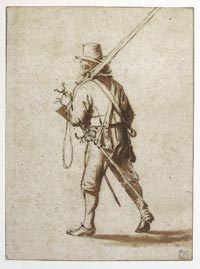
from Behind
Anthonie Palamdesz
1640s
Black chalk, brush and brown ink
205 x 152 mm
Metropolitan Museum of Art, New York
After the onset of the War with France in 1672, the presence of Catholics in the civic guard was a matter of some consequence, since the Dutch Republic was fighting against the Catholic Louis XIV, and there may have been some apprehension about using Catholics of doubtful loyalty in the country's defense. While the outskirts of Delft were not directly involved in the ensuing conflict and following French occupation, it had been flooded with refugees, especially from Tiel, who were overrun by the French.
The primary colors of the Delftse Schutterij (Delft Civic Guard) were black and white, the traditional colors of the city coat of arms. The patron saint was Saint Joris, already mentioned in the Chronycke van Ste. Ursulaas-kerk binnen der Stad Delft with the note that in 1411 the members of the Voetboogschutters ("crossbow shooters") had donated an altar dedicated to Saint Joris.
Shortly after the Union of Utrecht in 1579, a new Ordonnantie Der Schutterijen ende wachten binnen der Stadt Delft was published on May 12, 1580. It contained a new division of the civic guard into four vendels (companies). Each vendel had 120 shooters, each with a captain and lieutenants, as well as the vandeldrager (standard-bearer) and his lieutenants. The shooters were again divided in six rotten (squadrons), each with 20 shooters including their captains and lieutenants. The salary for a shooter was only twenty stuivers per year. Later the kloveniers were awarded an extra pound of gunpowder for their firearms.
Every facet of the towns' Night Watch and the opening and closing of the City Gates was strictly regulated. Subsequent revisions included among others a new division of the vendels in four quarters of the city, each marked with different colors. According to Dirck van Bleyswijk's Beschrijvinge der Stadt Delft (1667) these were: the groene (green) vendel for the first quarter, the oranje (orange) vendel for the second quarter, the witte (white) vendel for the third quarter and the blauwe vendel for the fourth quarter. In the Schuttersboek of 1674.
Vermeer and the Delft Civic Guard
In the Schuttersboek of 1674, Vermeer is listed as member of the first squadron of the oranje vendel commanded by Abraham Coeckebacker. We know that the acclaimed Delft painter (a family friend of the Vermeers) Leonaert Bramer (1596–1674), had been a sergeant in the same company and a member of a select group known as th Broederschape (Brotherhood of Knights ). Two other important figures in the life of Vermeer had played a role in the Delftse Schutterij. The first, Captain Teding van Berckhout (1643–1713), headed the second banner of the third quarter. Van Berckhout had once registered in a personal diary a visit to the Vermeer's studio. Although Van Berckhout's entry was very brief, it proves that the Delft artist enjoyed a certain fame since he was referred to as the "celebrated painter named Vermeer." Moreover, his membership probably brought him into contact with rich collectors and potential clients.
The second person was Anthony van de Wiel, sergeant of the first squadron in the second banner of the third quarter. Van de Wiel had been Vermeer's brother-in-law during Gertruy’s lifetime. Van de Wiel served under Captain Van Berckhout.
The exact date of Vermeer's enlistment in the Delftse Schutterij is unknown. It appears that the captains were possibly unaware of the painter's financial difficulties or perhaps by necessity or deference, they chose to ignore it. Perhaps the rules set down to guide the functioning of the schutterijen were applied with less rigidity. Nevertheless Vermeer certainly enjoyed a good reputation of an honorable citizen. He was elected twice as the chairman of the local Guild of Saint Luke, one of the most powerful organizations in Delft.
The schutterij activity no doubt allowed the painter to meet and interact with many outstanding burghers with whom they might not otherwise have encountered. The Captains, Lieutenants, and Ensigns were recruited among Delft's wealthiest and most powerful families (the Van Bleiswijcks, the Van der Dussens, the Graswinckels, the Van Lodensteyns, the Van Meermans, the Van Ruijvens, theVan Schilperoorts, and theVan der Voochts). The Sergeants were generally of less distinguished origin, and this group included well-known artists and other professional men. In the 1640s, well-known figures such as painters Bramer,Leonaert Bramer had been a sergeant in the same company; in uniform he wore a sash worth twelve guilders and during his time in service was a member of a select group of militiamen known as the Brotherhood of Knights. Bramer's small triptych model for the wall paintings he had done for the new Doelen on the Verwersdijk had as its central feature a panel showing the civic guards parading along a Delft street, banners flying. If after retiring from service at the age of sixty Bramer kept an eye on militia events, he would have seen Vermeer when training at target practice or guard feasts in the Doelen or during outdoor exercises in the new Cattlemarket, where Vermeer's father had been born. Anthony Bailey, Vermeer: A View of Delft (New York: Holt Paperbacks, 2002), 196. Following the Delftse Donderslag ( Delft Thunderclap) on October 12, 1654, the Delft Schutterij was allocated new premises called the Nieuwe Doelen, on Verwersdijk. In 1660, Bramer, Delft's most veneralbe painter and friend of the Vermeer family, was asked to decorate a room in this new lodging with frescos for a sum of one thousand guilders. Bramer was one of the few artists to have mastered this painting technique, which was popular mainly in Italy. This sum also included maintenance of the frescos.The fact that Bramer was also a sergeant with the schutterij no doubt helped his cause in obtaining this commission.
The schutterij was likely a major social network for artists such as Vermeer. Jacob Willemsz. Delff, and notary Willem de Langue served as Sergeants. De Langue, known for his frequent interactions with Bramer and the Vermeer family, was an earnest art collector. At his residence, it is possible that Vermeer observed paintings by Rembrandt, Roelandt Savery, and Bramer, to name a few. Furthermore, De Langue was acquainted with Johannes Renialme, an art dealer from Amsterdam who had been associated with the Delft Guild of St. Luke. Renialme's diverse collection could have provided young Vermeer with the opportunity to study works by Italian artists. It is documented that Renialme purchased at least one painting by Vermeer.
Even the ordinary members were of middle-class status and generally literate. The painter Herman van Steenwijck was involved in a shooting accident in 1636.
The schutter had to be prepared not only to try to repel foreign incursions but also to put down revolts against the regents' rule, such as the 1616 riots in Delft against a new tax on grain; then the schutters, 480 strong and armed with pikes and guns called "firelocks," were pelted with paving stones, disarmed by the mob, and forced to retreat. (The poet Westerbaen had said the Delft guards were as well-suited to their firelocks as donkeys to a lute.) Perhaps their hearts weren't in it. As mentioned, in September 1672 three of the four militia companies demanded that Delft's town council resign; their stance by then seemed, like that of much of the country, to be pro-Orange rather than pro-regent.Anthony Bailey, Vermeer: A View of Delft (New York: Holt Paperbacks, 2002), 196.
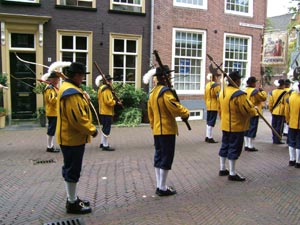
The inventory of 1676 of movable goods from Vermeer's estate (Vermeer died in 1675) lists an iron armor with a helmet and a pike in the groote zael (great hall). Pikes were used by the pikeniers from the infantry both for attacking foot soldiers or to defend their unit's musketeers from enemy cavalry. Pikeniers often held lower ranks within the Guard's hierarchy. In the recent past, these objects have been categorized as painter’s props, but this ignored the close connection between their specific function as armaments for the Delft schutterij and their location within the house.Pieter Roelfos, "Closer to Vermeer," in VERMEER, ed. Pieter Roelofs & Gregor Weber, Rijksmuseum, Amsterdam, 2023, 56.
Vermeer may have undertaken sentry duties, as pikes are typical weapons for watching at gates or doors within a castle. Two pikeniers were able to quickly block a gate or door for the first by crossing the long pikes, without shooting (and perhaps wounding the wrong person). However, being even a humble pikeman signified social acceptance. In 1674, one Delft schutter was dismissed from the militia because he was too poor, but Vermeer, though heavily in debt at the time, was evidently acceptable.
It is unlikely that Vermeer was involved in battles outside of Delft, perhaps he helped defend the city during the French invasion. Three-hundred schutters were sent to Geertruidenberg, Heusden, Den Briel, and Gorkum in 1672.
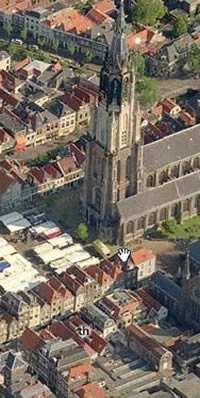
MICROSOFT'S Search Maps